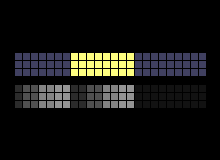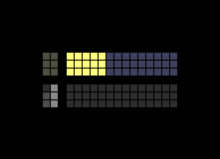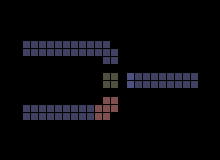Difference between revisions of "Electronics 101"
(→NTCT & PTCT) |
(→AND gate) |
||
| Line 49: | Line 49: | ||
=== AND gate === | === AND gate === | ||
| + | [[File:AND.png|220px|thumb|right|Logical AND gate]] | ||
== Advanced gates & logic == | == Advanced gates & logic == | ||
Revision as of 23:09, 7 December 2013
Contents
Conduction
Part one of this guide will cover the fundamentals of the primary metals/wires available in the game
First, we’ll start the the absolute most basic materials involved in electronics
METL
The most basic wire or conductor in the game, it conducts to almost any other conductive elements.
SPRK
Spark is the charged state of most conductors, it cannot be placed normally in the game like other materials, it has to be placed on top of a conductor to charge it. Any conductor that is charged will appear yellow and have a faint blue glow.
When a material is charged at a single point, it will try to spread outward like a wave in all directions.
Spark may jump very small (1 pixel) horizontal or vertical gaps (but not diagonally) to spread to another conductor, this is a very useful mechanic when it comes to working on a small scale, because it allows for the creation of more complicated arrangements of conductors so they don’t “short out”, it also allows for physical separation to prevent the transmission of heat while still being able to pass an electrical signal.
Internals
This is a quick explanation of how conduction works at a lower level, feel free to skip this part.
When you see charged metal in the game, it is actually a different element (SPRK), when spark spreads, it replaces the conductor (which must have a “life” of 0) with itself, setting the particle “life” to 4 and the “ctype” to the original element. When the “life” counts down and reaches zero, the SPRK will replace itself with the original element and set its “life” again to 4, as mentioned earlier, SPRK will only spread to “life” 0 conductor, setting the “life” to 4 creates a cool down timer that prevents it from looping back on itself indefinitely.
Advanced Conductors/Semiconductors
METL is the most basic conductor in the game, it alone is not sufficient when creating more complicated circuits, that place is filled by the other conductors available in the game; these conductors are where the fun happens, the reason for this is that they only conduct to certain conductors or only conduct under set conditions.
PSCN & NSCN
These two conductors where the first semiconductors introduced to the game, their core mechanic is that SPRK can move from PSCN to NSCN but not the other way around, this allows a junction of PSCN and NSCN to behave like a diode. PSCN is commonly used to activate powered materials while NSCN is used to deactivate them.
NTCT & PTCT
Negative / Positive Temperature Coefficient Thermistor, these two materials will only conduct when their ideal temperature is met, for NTCT, this is when it is hot (above 100C) and for PTCT this is when it is cold (below 100C). Both PTCT and NTCT will always receive charge from NSCN, but will only receive charge from PSCN when the previously mentioned temperature condition is met. Because of this, a PSCN - (P/N)TCT - NSCN junction will behave like a diode only when its temperate condition is met.
Furthermore, a nearby charge from METL will not pass through to (P/N)TCT, but it will cause it to heat rapidly to ~200oC. This allows the creation of an AND gate. This temperature based activation is only temporary as (P/N)TCT cools itself to 22C.



